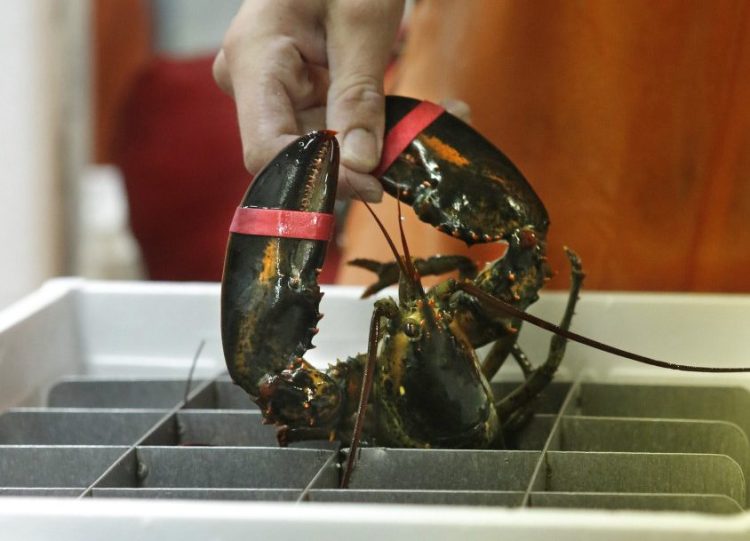Talk of a European ban on importing live American lobsters might have more to do with math than with science, some seafood export specialists say.
They say that banning live North American lobsters might be a way of giving European lobstermen a greater share of a market that currently seems to favor the taste of American and Canadian lobster over the native kind.
The National Fisheries Institute has “serious concerns” that Sweden’s move “could be a non-tariff (trade) barrier,” said Gavin Gibbons, a spokesman for the Virginia-based nonprofit.
That would be a way for European countries to protect the market for its native lobsters without provoking a trade war with the U.S. and Canada, and running the risk of retaliatory tariffs slapped on lucrative exports of European seafood to North America.
Gibbons said the National Fisheries Institute is encouraging the U.S. and Canadian governments to work together on a review of the “Swedish risk assessment” to help determine whether the concern is science- or trade-based.
Exporters and some scientists have scoffed at the Swedish concerns, saying that the “invasion” of North American lobsters involves only two or three dozen lobsters caught in European waters over the course of nearly a decade.
Still, Swedish authorities are pursuing their effort to have the European Union ban imports of North American lobster, arguing that it’s an invasive species that threatens the country’s native lobster population with diseases and potential cross-breeding and genetic mutations.
At stake is about $150 million in live lobster shipments from America to the EU, including more than $10 million in direct shipments from Maine, according to the research firm WISERtrade. The bulk of the live lobster – $125 million in 2015 – was shipped from Massachusetts, including much of Maine’s export catch, which is flown out of Boston’s Logan airport.
Maine-based scientists dispute the concerns that the American lobsters are threatening their European cousins with diseases.
Robert Bayer, executive director of the University of Maine’s Lobster Institute, said there is no scientific basis for Sweden’s proposed ban. He said Swedish officials have expressed concerns about the spread of three diseases: epizootic shell disease, gaffkemia or “red-tail,” and white spot syndrome.
• Shell disease, a bacterial infection that causes black lesions on lobsters’ shells and can be fatal, has been shown in scientific studies not to be contagious, he said. In fact, no one has been able to make it spread from one lobster to another under controlled conditions.
• Red-tail, a bacteria-caused infectious disease, is no longer present in the American lobster population, Bayer said. “I haven’t seen that for about 10 years, so it’s gone.”
• White spot syndrome, a highly lethal and contagious viral infection, does not affect lobsters, he said. Only shrimp can catch white spot syndrome.
Norway, acting on Swedish concerns, banned imports of North American lobsters beginning Jan. 1, although it’s a porous ban.
Because Norway is not part of the EU, it could act alone and not wait for a panel representing 28 nations to debate and possibly enact a ban.
Jeffrey Bennett, a trade specialist with the Maine International Trade Center, said it could be months before the EU acts.
Jon-Age Øyslebo, spokesman for the Norwegian Embassy in Washington, said Norway acted “in parallel” with Sweden to investigate the presence of North American lobsters in Scandinavian waters.
He said he didn’t know if any North American lobsters have been found in Norwegian waters. However, he said Norway shares Sweden’s concerns over the possible impact of North American lobsters establishing themselves in Europe.
Øyslebo said the ban went into effect Jan. 1 and was being enforced, although trade figures don’t reflect that.
According to WISERtrade, a firm that tracks international trade, Norway imported $112,000 worth of live Maine lobsters in January and another $151,000 in February. That pace is ahead of imports last year, when Norway received about $1 million in live Maine lobsters over all of 2015.
Øyslebo said he couldn’t explain the disparity between the ban on live lobster imports that he said is being enforced and the WISERtrade figures.
He did say, however, that there are “ongoing discussions” about the ban in Norway, but he didn’t know if the government was considering lifting it.
And he dismissed suggestions that the ban reflects anything other than science-based concern over invasive species.
One reason, he said, is that Norway’s lobster fishery is tiny. The total catch of lobster last year was 46 tons, valued at roughly $1.2 million (U.S.), “marginal in a Norwegian fisheries context,” said Øyslebo. By comparison, Maine lobstermen hauled in nearly 53,000 tons of lobster last year, valued at $495 million.
He also said the fishery is highly regulated and lobsters are allowed to be harvested only during the last quarter of the year.
“It seems far-fetched to believe that it’s a trade-related issue,” Øyslebo, said. “From our perspective, it’s a purely environmental issue.”
Copy the Story Link
Send questions/comments to the editors.




Success. Please wait for the page to reload. If the page does not reload within 5 seconds, please refresh the page.
Enter your email and password to access comments.
Hi, to comment on stories you must . This profile is in addition to your subscription and website login.
Already have a commenting profile? .
Invalid username/password.
Please check your email to confirm and complete your registration.
Only subscribers are eligible to post comments. Please subscribe or login first for digital access. Here’s why.
Use the form below to reset your password. When you've submitted your account email, we will send an email with a reset code.